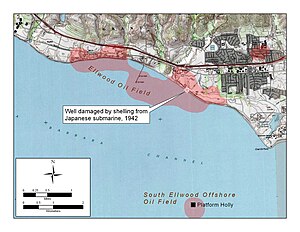| Bombardment of Ellwood | |||||||
|---|---|---|---|---|---|---|---|
| Part of World War II Pacific War | |||||||
 The Ellwood Oil Field and the location of the Japanese attack.]] | |||||||
| |||||||
| Belligerents | |||||||
|
|
| ||||||
| Commanders and leaders | |||||||
| N/A |
| ||||||
| Strength | |||||||
| N/A | 1 submarine | ||||||
| Casualties and losses | |||||||
|
none, Ellwood slightly damaged | none | ||||||
The Bombardment of Ellwood during World War II was a naval attack by a Japanese submarine against United States coastal targets near Santa Barbara, California. Though damage was minimal the event was key in triggering the West Coast invasion scare and influenced the decision to intern Japanese-Americans.
Background
Following the December 7, 1941 attack on Pearl Harbor, Hawaii, seven Japanese submarines patroled the American West Coast. They attacked several merchant vessels and skirmished twice with United States Navy air or sea forces. The Japanese destroyed several merchant vessels though many engagements ended indecisively. By the end of December, the submarines steamed backed to friendly waters to resupply. Many went to Kwajalein and then returned to American waters. Imperial Japanese Navy submarine I-17 was one of these vessels. She displaced 3,654 tons when below the waterline and was 356.5 feet long. Her armament included six 20-inch torpedo tubes with seventeen spare torpedos in total. Up top was a 5.5-inch deck gun, the weapon used by the Japanese. I-17 carried 101 officers and crew under Commander Kozo Nishino.
Nishino's experience included service with the Japanese fleet assigned to Operation Hawaii. He also skippered a merchant ship which before the war steamed in the Santa Barbara Channel extensively. Nishino personally visited the Ellwood Oil Field where his ship filled up with oil and then steamed back to Japan. During one vist he tripped and fell onto a prickly pear and was thorned by several needles in his behind. The thorns were pulled out which prompted laughter from nearby oilmen. The field would be his target during the bombardment. The Majority of damage inflicted by the sumbarine was located around 300 meters from where Nishino had fallen into the cactus.
Bombardment
At about 7:00 pm on February 23, 1942, I-17 came to a stop off Ellwood in the oil field. Commander Nishino ascended the stairs to the conning tower and gave the order to prepare for action. A gunner crew quickly manned the deck gun and took aim at a huge Richfield aviation fuel tank just beyond the beach. Nishino ordered his men to fire at about 7:15 pm, the first few shots hit within one of the refineries. Being nightime most of the oilers had gone home but a few remained on duty, they heard the first rounds when they slammed into their workplace. At first they suspected an internal explosion but then one worker spotted I-17 in the dark. Later an oiler by the name of G. Brown described I-17 as being so big that he thought it was a cruiser or destroyer until realizing that only one gun was being fired from the large Japanese submarine. Nishino then switchted targets to the second refinery. Brown and a few others informed the authorities nearby and the alarm was raised. By this time Nishino's men had fired several more shots which were apparently not well directed.
Shots hit ranch outside of Ellwood. A shell flew over Wheeler's Inn, and owner Laurence Wheeler called the Santa Barbara Sheriff's department. The Sheriff working the phones told Wheeler that warplanes would arrive shortly but no planes were ever sortied. I-17 hit the Ellwood Pier, and damaged it slightly. The oilers suffered the loss of a derrick, a pumphouse and a catwalk was also hit. After twenty minutes of firing Commander Nishino ordered his ship to steam. Reverend Arthur Basham observed the withdrawal of the Japanese vessel from Montecito. He later reported to the Sheriff's department that the submarine headed south towards Los Angeles, flashing signal lights to the shore. I-17 escaped and the engagement ended without the loss of life. Twelve to twenty-five 140 mm rounds were fired by the Japanese.
Aftermath
Several people in Santa Barbara witnessed the signal lights of the Japanese submarine so a black out was ordered until being lifted at 12:12 am the folowing morning. Nishino's bombardment was immediatedly reported by various news agencies which sent word of the event across the country. Hundreds of people fled following the attack and the price of land along the coast fell to historic low prices. The event also helped justify the internment of Japanese-Americans which began a week later on March 2. The following night on February 24th, 1942 the Battle of Los Angeles began in which United States coastal defences engaged for hours an unidentified flying object which at the time was assumed to be enemy aircraft.
The Japanese submarines assigned to duty off North America continued to operate against allied shipping, they also bombarded Fort Stvens along the Columbia River and attacked a Canadian lighthouse on Vancouver Island. Despite being ordered to attack capitol ships whenever possible, the submarines ultimately engaged only in attacks against merchant vessels and minor bombardments of targets ashore. Also, two air raids were launched via submarine, in a failed attempt to start a forest fire in southwest Oregon.
See Also
- Attack on Orlean
References
- Official Chronology of the US Navy in World War II: Chapter V: 1943
- Graham, Otis L.; Bauman, Robert; Dodd, Douglas W.; Geraci, Victor W.; Murray, Fermina Brel. Stearns Wharf: Surviving Change on the California Coast. Graduate Program in Public Historical Studies, University of California, 1994 ISBN 1-883535-15-8
- Parshall, Jon; Hackett, Bob and Kingsepp, Sander. Imperial Japanese Navy Page: HIJMS Submarine I-17: Tabular Record of Movement http://www.combinedfleet.com/I-17.htm. Retrieved 7/4/2010
- Webber, Bert. Silent Siege: Japanese Attacks Against North America in World War II, Ye Galleon Press, Fairfield, Washington, 1984 ISBN 0-87770-315-9 (hardcover). ISBN 0-87770-318-3